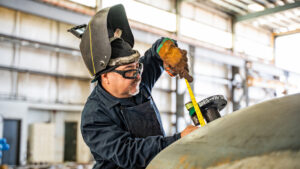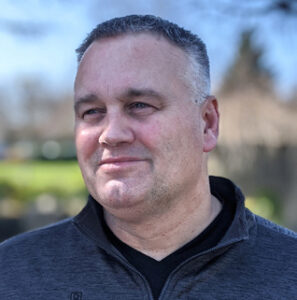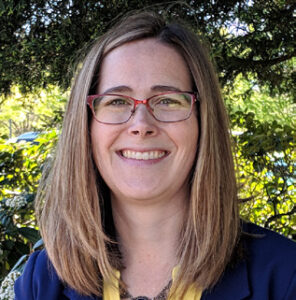With over 900 employees, Northwest Pipe Company is the largest manufacturer of engineered steel water pipe systems in North America. In order to support its employees, increase its institutional resilience and productivity, and improve its recruitment, Northwest Pipe has adopted a new approach to its diversity and inclusion initiatives and will support them with activities furthering recognition, training, and communications. In this interview, Northwest Pipe Director, President, and CEO Scott Montross and Vice President of Human Relations (HR) Megan Kendrick share more about the motivation and goals of the company’s diversity and inclusion initiatives.
Municipal Water Leader: Please tell us about your backgrounds and how you came to be in your current positions.
Scott Montross: I have served as Northwest Pipe Company’s director, president, and CEO since January 2013. I am a graduate of Colgate University and joined the company in May 2011 after 23 years in the steel industry. I have held many senior positions, including executive vice president of the flat products group for Evraz Inc. NA’s Oregon steel division, Claymont steel division, and Regina steel division. Prior to Evraz Inc. NA, I held positions with Oregon Steel Mills and the National Steel Corporation.
Megan Kendrick: I joined Northwest Pipe Company in 2008 as a manager in our accounting department. I held a variety of positions with increasing responsibility in both accounting and HR before being appointed to the position of vice president of HR in January 2017. As the head of HR, I am responsible for overseeing all employee matters, including compensation, benefits, compliance, and employee relations. I hold both a CA-CPA and a SHRM-CP designation, which reflect my background in both accounting and HR.
Municipal Water Leader: When and why did Northwest Pipe adopt its current approach to diversity and inclusion?
Scott Montross: Northwest Pipe has had a long history of equal employment and affirmative action practices, but within the last year, we have actively started to transform our efforts from being just about compliance to be a more organic part of who we are as a company. It’s increasingly clear that a commitment to diversity and inclusion is not just the right thing to do but is also good business. Multiple studies have confirmed that organizations diverse in age, race, ethnicity, gender identity, sexual orientation, physical and mental ability, and perspectives are more resilient and productive. Research has also shown that employees at organizations with diversity and inclusion strategies are more likely to feel engaged in their work.
Our approach starts at the top. Our diversity and inclusion plan is championed by our executive leadership team and our board of directors. After establishing a corporate commitment to equity and inclusion, we created

and enhanced policies to support that commitment and made our commitment known by starting 2021 with a company-wide message from me regarding our diversity and inclusion efforts. Our next step is building on this shared commitment with input from employees at every level and in every facility that we operate. We expect and look forward to evolving and adding to our initiatives with the informed feedback of the diverse voices on our team.
Municipal Water Leader: What policies have been put in place so far, and what other policies are you currently developing?
Megan Kendrick: Northwest Pipe has policies in place related to equal employment opportunity and affirmative action. We have enhanced these compliance-focused policies with a specific diversity and inclusion statement that was written last year and will be rolled out to employees this year as part of ongoing employee training and development. Some of the initiatives supporting our policies and commitment beginning in 2021 include:
• Recognition: commemorating diverse milestones and observances that celebrate various cultures and populations through social media and internal activities;
• Training: ongoing leadership training that includes ways to foster inclusive behaviors, challenge unconscious biases, embrace differences, and be more supportive of employees from diverse backgrounds or with different abilities; and
• Communications: encouraging open conversations where all voices are heard and respected and where all employees are comfortable participating in dialogue on diversity and inclusion topics.
Municipal Water Leader: How do these policies help Northwest Pipe recruit and retain new employees?
Scott Montross: As U.S. demographics continue to shift, we need to attract a more diverse pool of talent from a variety of backgrounds with specific skill sets. These diverse applicants are seeking an inclusive company culture where they will feel welcomed, valued, and understood.
As we continue to develop our diversity and inclusion program and review our succession plans for our management team, we also are looking to identify individuals from historically underrepresented ethnic and gender groups who have potential for advancement in the company. By fostering an inclusive culture where employees feel that they are welcomed, valued, and understood, and offering training and development opportunities for high-performing employees, Northwest Pipe seeks to establish itself as a preferred employer in our markets.
Municipal Water Leader: What goals does Northwest Pipe hope to reach with these policies? What results has the company seen so far?
Megan Kendrick: It’s easier to talk about goals with diversity, which can be measured by gathering and analyzing data on our workforce demographics. We gather our affirmative action data on an annual basis, specifically data related to gender, ethnicity, veteran status, and disabilities, and compare our activities related to recruiting, hiring, retention, and promotion to benchmark goals that were established in the previous year. In the past, these conversations have largely occurred at an HR level, but with our aim to be more transparent, we will be having more focused conversations about our measurable diversity goals with the management team. One of our long-identified goals and challenges relates to the recruitment of women to manufacturing-focused roles. Recently, we have had success in hiring and promoting women into these nontraditional roles at several of our manufacturing facilities, which is a great step forward. With the new U.S. Securities and Exchange Commission human capital reporting requirements, we will aim to be more transparent about our workforce demographics and the progress that we are making toward our goals.
Inclusion is more difficult, because it is not something that we can measure or put a number on. Instead, inclusion is about employee experience and how Northwest Pipe’s culture supports employees from all demographics—not just the ones that we officially measure. This is an area in which there will always be room for growth and in which listening and reacting to employee feedback will be especially vital for success.
Scott Montross: Our goal has always been to employ the most skilled group of workers, regardless of age, gender identity, race, sexual orientation, physical or mental ability, ethnicity, political affiliation, socioeconomic status, veteran status, or any other characteristics that make them unique. However, we haven’t been as vocal about our inclusion efforts until this year. We are looking forward to receiving feedback from our employees over the course of the year as we continue with a communications plan centered around inclusion and provide opportunities for employees to meet and discuss their viewpoints in conjunction with training that is planned for later this year.

Scott Montross is Northwest Pipe Company’s director, president, and CEO.

Megan Kendrick is Northwest Pipe Company’s vice president of human resources.
For more on Northwest Pipe, contact info@nwpipe.com.
